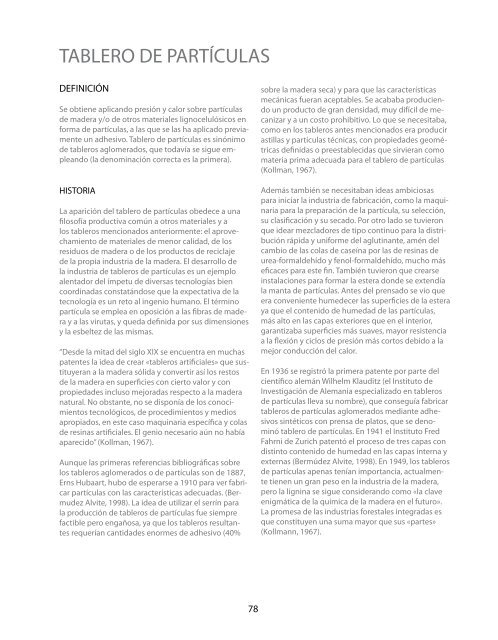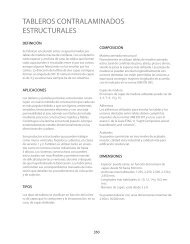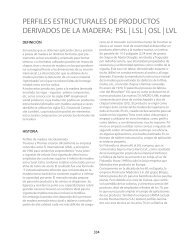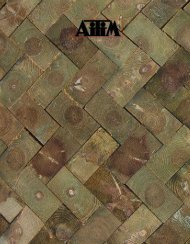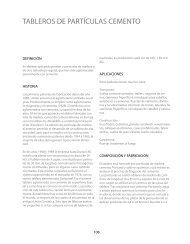productos de madera para la arquitectura – cscae - Consejo ...
productos de madera para la arquitectura – cscae - Consejo ...
productos de madera para la arquitectura – cscae - Consejo ...
You also want an ePaper? Increase the reach of your titles
YUMPU automatically turns print PDFs into web optimized ePapers that Google loves.
TABLERO DE PARTÍCULAS<br />
DEFINICIÓN<br />
Se obtiene aplicando presión y calor sobre partícu<strong>la</strong>s<br />
<strong>de</strong> ma<strong>de</strong>ra y/o <strong>de</strong> otros materiales lignocelulósicos en<br />
forma <strong>de</strong> partícu<strong>la</strong>s, a <strong>la</strong>s que se <strong>la</strong>s ha aplicado previamente<br />
un adhesivo. Tablero <strong>de</strong> partícu<strong>la</strong>s es sinónimo<br />
<strong>de</strong> tableros aglomerados, que todavía se sigue empleando<br />
(<strong>la</strong> <strong>de</strong>nominación correcta es <strong>la</strong> primera).<br />
HISTORIA<br />
La aparición <strong>de</strong>l tablero <strong>de</strong> partícu<strong>la</strong>s obe<strong>de</strong>ce a una<br />
filosofía productiva común a otros materiales y a<br />
los tableros mencionados anteriormente: el aprovechamiento<br />
<strong>de</strong> materiales <strong>de</strong> menor calidad, <strong>de</strong> los<br />
residuos <strong>de</strong> ma<strong>de</strong>ra o <strong>de</strong> los <strong>productos</strong> <strong>de</strong> recic<strong>la</strong>je<br />
<strong>de</strong> <strong>la</strong> propia industria <strong>de</strong> <strong>la</strong> ma<strong>de</strong>ra. El <strong>de</strong>sarrollo <strong>de</strong><br />
<strong>la</strong> industria <strong>de</strong> tableros <strong>de</strong> partícu<strong>la</strong>s es un ejemplo<br />
alentador <strong>de</strong>l ímpetu <strong>de</strong> diversas tecnologías bien<br />
coordinadas constatándose que <strong>la</strong> expectativa <strong>de</strong> <strong>la</strong><br />
tecnología es un reto al ingenio humano. El término<br />
partícu<strong>la</strong> se emplea en oposición a <strong>la</strong>s fibras <strong>de</strong> ma<strong>de</strong>ra<br />
y a <strong>la</strong>s virutas, y queda <strong>de</strong>finida por sus dimensiones<br />
y <strong>la</strong> esbeltez <strong>de</strong> <strong>la</strong>s mismas.<br />
“Des<strong>de</strong> <strong>la</strong> mitad <strong>de</strong>l siglo XIX se encuentra en muchas<br />
patentes <strong>la</strong> i<strong>de</strong>a <strong>de</strong> crear «tableros artificiales» que sustituyeran<br />
a <strong>la</strong> ma<strong>de</strong>ra sólida y convertir así los restos<br />
<strong>de</strong> <strong>la</strong> ma<strong>de</strong>ra en superficies con cierto valor y con<br />
propieda<strong>de</strong>s incluso mejoradas respecto a <strong>la</strong> ma<strong>de</strong>ra<br />
natural. No obstante, no se disponía <strong>de</strong> los conocimientos<br />
tecnológicos, <strong>de</strong> procedimientos y medios<br />
apropiados, en este caso maquinaria específica y co<strong>la</strong>s<br />
<strong>de</strong> resinas artificiales. El genio necesario aún no había<br />
aparecido” (Kollman, 1967).<br />
Aunque <strong>la</strong>s primeras referencias bibliográficas sobre<br />
los tableros aglomerados o <strong>de</strong> partícu<strong>la</strong>s son <strong>de</strong> 1887,<br />
Erns Hubaart, hubo <strong>de</strong> esperarse a 1910 <strong>para</strong> ver fabricar<br />
partícu<strong>la</strong>s con <strong>la</strong>s características a<strong>de</strong>cuadas. (Bermu<strong>de</strong>z<br />
Alvite, 1998). La i<strong>de</strong>a <strong>de</strong> utilizar el serrín <strong>para</strong><br />
<strong>la</strong> producción <strong>de</strong> tableros <strong>de</strong> partícu<strong>la</strong>s fue siempre<br />
factible pero engañosa, ya que los tableros resultantes<br />
requerían cantida<strong>de</strong>s enormes <strong>de</strong> adhesivo (40%<br />
78<br />
sobre <strong>la</strong> ma<strong>de</strong>ra seca) y <strong>para</strong> que <strong>la</strong>s características<br />
mecánicas fueran aceptables. Se acababa produciendo<br />
un producto <strong>de</strong> gran <strong>de</strong>nsidad, muy difícil <strong>de</strong> mecanizar<br />
y a un costo prohibitivo. Lo que se necesitaba,<br />
como en los tableros antes mencionados era producir<br />
astil<strong>la</strong>s y partícu<strong>la</strong>s técnicas, con propieda<strong>de</strong>s geométricas<br />
<strong>de</strong>finidas o preestablecidas que sirvieran como<br />
materia prima a<strong>de</strong>cuada <strong>para</strong> el tablero <strong>de</strong> partícu<strong>la</strong>s<br />
(Kollman, 1967).<br />
A<strong>de</strong>más también se necesitaban i<strong>de</strong>as ambiciosas<br />
<strong>para</strong> iniciar <strong>la</strong> industria <strong>de</strong> fabricación, como <strong>la</strong> maquinaria<br />
<strong>para</strong> <strong>la</strong> pre<strong>para</strong>ción <strong>de</strong> <strong>la</strong> partícu<strong>la</strong>, su selección,<br />
su c<strong>la</strong>sificación y su secado. Por otro <strong>la</strong>do se tuvieron<br />
que i<strong>de</strong>ar mezc<strong>la</strong>dores <strong>de</strong> tipo continuo <strong>para</strong> <strong>la</strong> distribución<br />
rápida y uniforme <strong>de</strong>l aglutinante, amén <strong>de</strong>l<br />
cambio <strong>de</strong> <strong>la</strong>s co<strong>la</strong>s <strong>de</strong> caseína por <strong>la</strong>s <strong>de</strong> resinas <strong>de</strong><br />
urea-formal<strong>de</strong>hído y fenol-formal<strong>de</strong>hído, mucho más<br />
eficaces <strong>para</strong> este fin. También tuvieron que crearse<br />
insta<strong>la</strong>ciones <strong>para</strong> formar <strong>la</strong> estera don<strong>de</strong> se extendía<br />
<strong>la</strong> manta <strong>de</strong> partícu<strong>la</strong>s. Antes <strong>de</strong>l prensado se vio que<br />
era conveniente hume<strong>de</strong>cer <strong>la</strong>s superficies <strong>de</strong> <strong>la</strong> estera<br />
ya que el contenido <strong>de</strong> humedad <strong>de</strong> <strong>la</strong>s partícu<strong>la</strong>s,<br />
más alto en <strong>la</strong>s capas exteriores que en el interior,<br />
garantizaba superficies más suaves, mayor resistencia<br />
a <strong>la</strong> flexión y ciclos <strong>de</strong> presión más cortos <strong>de</strong>bido a <strong>la</strong><br />
mejor conducción <strong>de</strong>l calor.<br />
En 1936 se registró <strong>la</strong> primera patente por parte <strong>de</strong>l<br />
científico alemán Wilhelm K<strong>la</strong>uditz (el Instituto <strong>de</strong><br />
Investigación <strong>de</strong> Alemania especializado en tableros<br />
<strong>de</strong> partícu<strong>la</strong>s lleva su nombre), que conseguía fabricar<br />
tableros <strong>de</strong> partícu<strong>la</strong>s aglomerados mediante adhesivos<br />
sintéticos con prensa <strong>de</strong> p<strong>la</strong>tos, que se <strong>de</strong>nominó<br />
tablero <strong>de</strong> partícu<strong>la</strong>s. En 1941 el Instituto Fred<br />
Fahrni <strong>de</strong> Zurich patentó el proceso <strong>de</strong> tres capas con<br />
distinto contenido <strong>de</strong> humedad en <strong>la</strong>s capas interna y<br />
externas (Bermú<strong>de</strong>z Alvite, 1998). En 1949, los tableros<br />
<strong>de</strong> partícu<strong>la</strong>s apenas tenían importancia, actualmente<br />
tienen un gran peso en <strong>la</strong> industria <strong>de</strong> <strong>la</strong> ma<strong>de</strong>ra,<br />
pero <strong>la</strong> lignina se sigue consi<strong>de</strong>rando como «<strong>la</strong> c<strong>la</strong>ve<br />
enigmática <strong>de</strong> <strong>la</strong> química <strong>de</strong> <strong>la</strong> ma<strong>de</strong>ra en el futuro».<br />
La promesa <strong>de</strong> <strong>la</strong>s industrias forestales integradas es<br />
que constituyen una suma mayor que sus «partes»<br />
(Kollmann, 1967).


